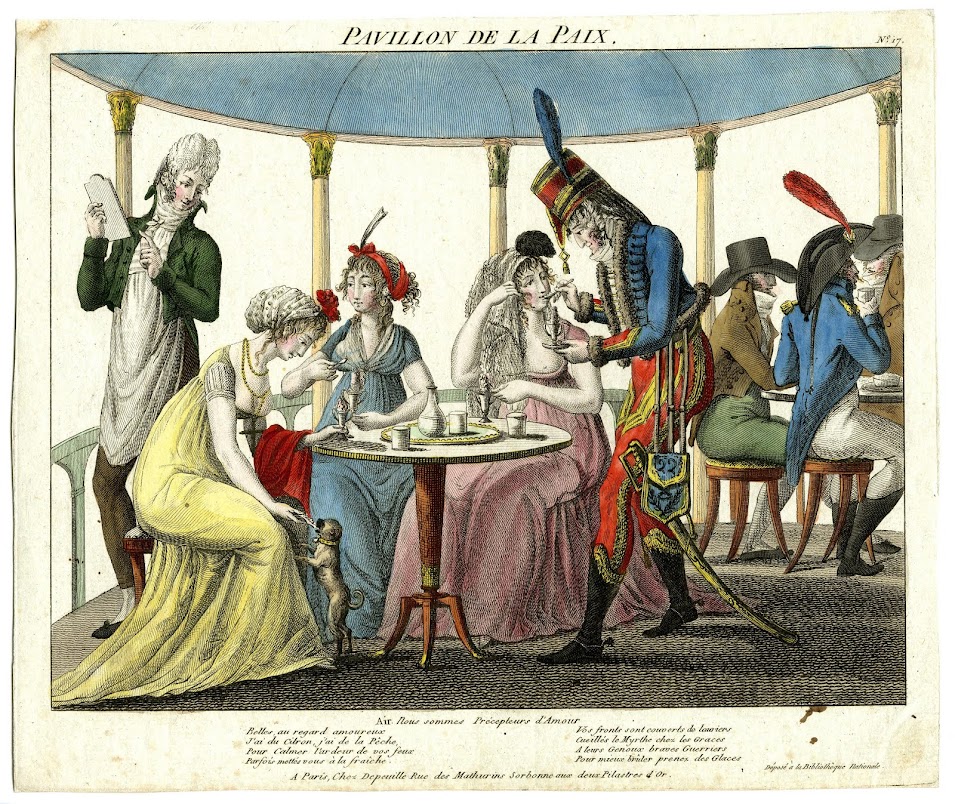The "Toilettengeschenk für Damen" - or "A Gift for Ladies"
 |
| CC Zero, courtesy of Universitäts-und Landesbibliothek Düsseldorf |
I feel blessed and privileged to have the fourth issue in my personal library, the year 1808 to be precise. This is a marvellous annual publication, published by Georg Voss in Leipzig.
The first three issues are available for download at the Universitäts- und Landesbibliothek Düsseldorf
If you follow this link, you will find yourself at the main page, where a click on "PDF" next to the publication allows you a One-PDF download, instead of the "bit by bit" on the direct links.
The Publication is destined to every lady who wants to improve her accomplishments, includes treaties on elegant movement, music (for beginners and more proficient musicians), embroidery (and knitting!), literature, poetry, drawing, dancing and domestic economy.
 |
| CC Zero ULB Düsseldorf, a knitting pattern and instructions. Zweites Toiletten-Geschenk, 1806 |
I'd say, if I'd be a lady back then, this might have been one of my yearly subscriptions of choice, and even today I am scouring antique dealers to find other volumes.
I hope in time I will be able to digitise the year 1808, as it's too good a publication not to share, and it's one what is not online at the moment.
But today I'd like to invite you into the year 1806. It was inspired by a conversation I've had with a dear friend today, the old chestnut of "Should dance dresses have trains, or not?" and I remembered the Zweite Toiletten-Geschenk:
While perusing the delightful publications, an illustration in the dance section of the second tome caught my eye. It was a lady, coming out of a minuet*, holding a train.
I've immediately let go of the bit I was actually reading, and searched the description. Yes! It is the illustration of how to hold a trained dress when dancing. because the writer thought, that as trains will remain fashionable for quite a while, he'd better give a hint on how to manage it as elegantly as possible:
Transcription of the German text (page 121)
Figur 6 hat eine Schleppe. Da solche noch lange Mode bleiben dürften, ob sie gleich beym Tanz unassend sind, so ist doch zu bemerken, dass, wenn es einmal eine Schleppe seyn muss, sie am Tanzkleide recht lang seyn möchte, um, mit Geschicklichkeit aufgenommen, der Draperie eine gefällige Leichtigkeit zu geben - wobey die Füsse die notwendige Freyheit behalten. Eine kurze Schleppe ist für das Auge unangenehm beym Tanze. Das Kleid ist gespannt um die Füsse, und Steifheit tritt an die Stelle der Freyheit.
Translation:
Fig. 6 has a train. As those will remain in fashion for quite some time, despite being ill suited for dancing; it should be mentioned that IF it needs to be a train, it should be rather long on a dance dress, thus be taken up with skill, to create an airy drapery - and the feet keep their freedom of movement. A short train is ugly to the eye when dancing. The dress pulls around the feet, and stiffness takes the place of freedom.
 |
| Voss emphasises the round arms, and despises too edgy figures; thus encourages his readers to practice wavy movement and carrying of their arms |
Even after all those years since I've read this passage, it makes me happy and giddy to have come across yet another glimpse, yet another facet, yet another angle of the time, and finally I found the time and the inspiration to sit down and share this nugget with you.
If you stumble about original sources dance dresses with trains and how to deal with them, please do not be shy, I'd be happy to see other sources. Many people go by Jane Austen, when in Northanger Abbey it is mentioned how Catherine and Isabella pin up their trains "They called each other by their Christian name, were always arm in arm when they walked, pinned up each other’s train for the dance and were not to be divided in the set;[…]", yet I am more than curious to read other references.
I'd like to end this post with two more drawings on elegant movement (the issue also included exercises on how to achieve such elegance):
 |
| Dance Positions |
 |
| Positions of dance and again, elegant hand and arm positions by the dancers |
*Yes, the minuet was still part of a dancer's curriculum. Every ball of consequence would open with one, and it was deemed to be _the dance_ what needed to be mastered to be able to dance (slow movements give away sloppy footwork much more easily...)




No comments:
Post a Comment